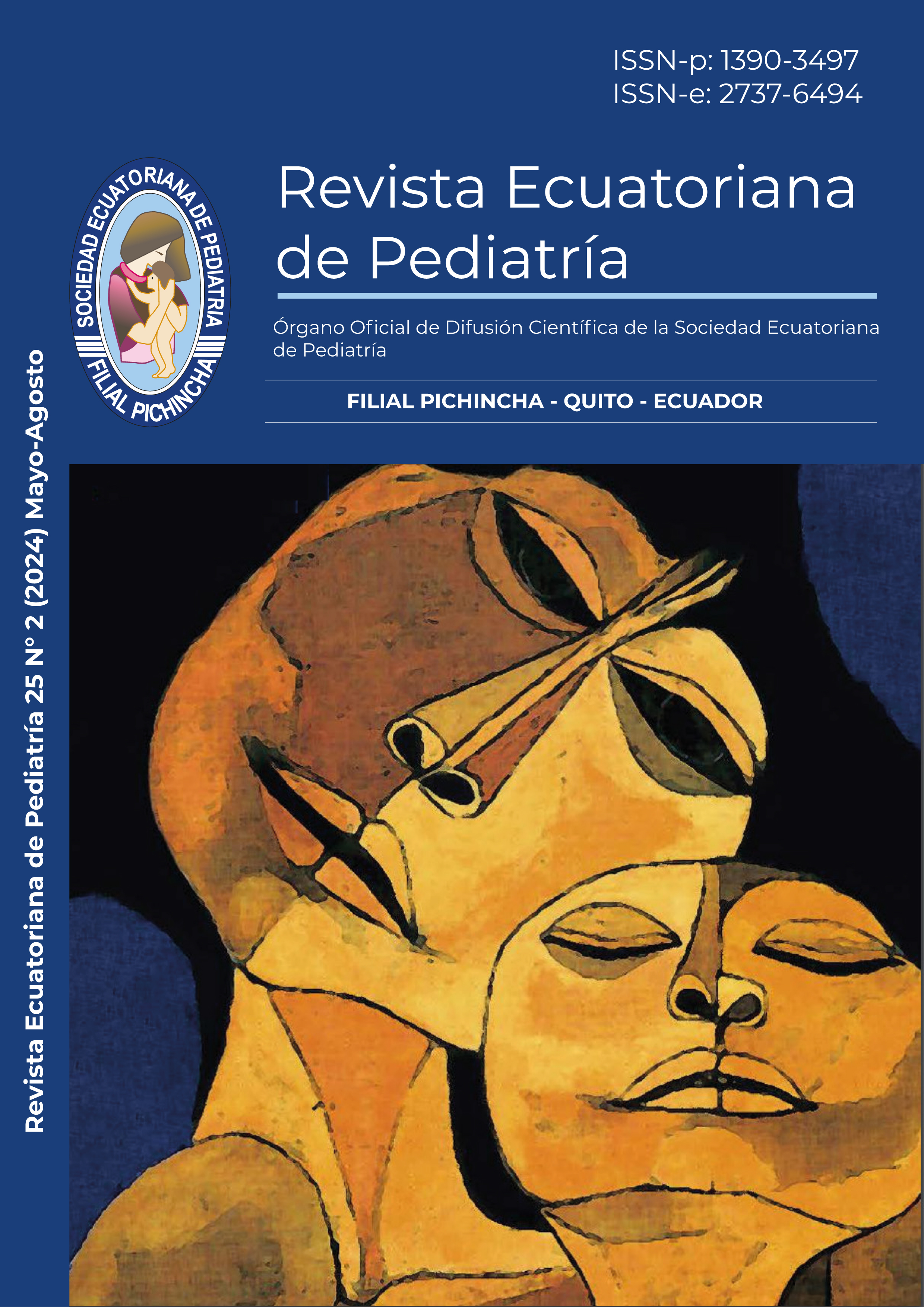Hypereosinophilic syndrome in a pediatric patient. Case report
Main Article Content
Abstract
Introduction: Hypereosinophilic syndrome (HES) corresponds to a group of disorders characterized by an eosinophil count in peripheral blood greater than 1500/μL, causing lysis in different organs due to the release of inflammatory mediators and eosinophilic infiltration. It is a rare pathology with a higher incidence in pediatric age (9:1) and, although its etiology is unknown, it has been determined that it may be due to specific clonal disorders. It has a wide variety of clinical manifestations, ranging from incidental hypereosinophilia to the abrupt development of a serious and potentially fatal condition. The diagnostic approach is based on an adequate history and physical examination, supported by findings in complementary examinations to rule out secondary causes of eosinophilia. Regarding treatment, in the case of degranulated eosinophil count of 1x109/l and/or life-threatening organ dysfunction, it should be started immediately, consisting mainly of corticosteroids. Clinical Case: Preschooler aged 5 years and 3 months, immunocompetent, with a history of incomplete vaccinations and resident in a rural area, with a clinical picture of one month of evolution prior to admission characterized by persistent fever despite antipyretic, headache, asthenia, hyporexia and paleness. The physical examination showed axillary lymphadenopathy and hepatomegaly, with a biometry report with leukocytosis at 62,660 x103/ul with eosinophilia of 83% (52,007 absolute neutrophil count). Patient’s evolution: Due to its clinical presentation, a diagnostic approach was performed, finding severe hypereosinophilia in biometry and confirmed by peripheral blood smear and bone marrow aspiration. A search for parasitic, infectious, allergic, neoplastic and pharmacological causative agents began, finding toxocara canis positive as a probable initial trigger in complementary tests, and receiving respective treatment. Due to persistence of hypereosinophilia despite therapeutics and potential risk of damage to target organs, treatment with prednisone and hydroxyurea was started, with partial response, without having a clear etiology so far, and he remains under comprehensive outpatient follow-up by specialties. Conclusions: Hypereosinophilic syndrome is a rare clinical entity that can go unnoticed and be underdiagnosed, but can cause severe organic damage and serious complications, which is why it requires a thorough evaluation of its etiology to provide appropriate treatment and treatment. This way, avoid injuries to the target organ. This is why it is of great importance to have close multidisciplinary monitoring and timely treatment of these cases.
Downloads
Article Details

This work is licensed under a Creative Commons Attribution-NonCommercial-ShareAlike 4.0 International License.
References
Chen E. Rosenberg, Patricia C. Fulkerson, Kelli W. Williams, Diagnosis and Management of Pediatric Hypereosinophilic Syndrome, The Journal of Allergy and Clinical Immunology: In Practice, Volume 10, Issue 5, 2022, Pages 1131-1138, ISSN 2213-2198,
Zheng HT, Xu Y, Yan XY, Yan YB, Ma SX, Liu LL, Zhao QY. Pediatric hypereosinophilic syndrome associated with liver damage, portal vein, splenic vein and superior mesenteric vein thromboses: a case report. BMC Pediatr. 2023 May12;23(1):233. doi: 10.1186/s12887-023-04014-0. PMID: 37173706; PMCID: PMC10176765.
Wei X, Li X, Wei Z, Zhang H, Deng J, Xing S, Zhang J. Clinical analysis of hypereosinophilic syndrome first presenting with asthma-like symptoms. Ann Med. 2022 Dec;54(1):11-21. doi: 10.1080/07853890.2021.2014555. PMID: 34935570; PMCID: PMC8725856.
Jin J, Yu H. Severe Idiopathic Hypereosinophilic Syndrome with Eosinophilic Cholecystitis in a Child Treated with Mepolizumab. Indian J Pediatr. 2024 May;91(5):526. doi: 10.1007/s12098-023-05007-8. Epub 2023 Dec 30. PMID: 38159150
Xie J, Zhang J, Zhang X, Zhang Q, Chung KF, Wang C, Lai K. Cough in hypereosinophilic syndrome: case report and literature review. BMC Pulm Med. 2020 Apr 15;20(1):90. doi: 10.1186/s12890-020-1134-x. PMID: 32293378; PMCID: PMC7158094.
Caminati M, Brussino L, Carlucci M, Carlucci P, Carpagnano LF, Caruso C, Cosmi L, D’Amore S, Del Giacco S, Detoraki A, Di Gioacchino M, Matucci A, Mormile I, Granata F, Guarnieri G, Krampera M, Maule M, Nettis E, Nicola S, Noviello S, Pane F, Papayannidis C, Parronchi P, Pelaia G, Ridolo E, Rossi FW, Senna G, Triggiani M, Vacca A, Vivarelli E, Vultaggio A, de Paulis A. Managing Patients with Hypereosinophilic Syndrome: A Statement from the Italian Society of Allergy, Asthma, and Clinical Immunology (SIAAIC). Cells. 2024 Jul 11;13(14):1180.
Del Bel KL, Ragotte RJ, Saferali A, Lee S, Vercauteren SM, Mostafavi SA, Schreiber RA, Prendiville JS, Phang MS, Halparin J, Au N, Dean JM, Priatel JJ, Jewels E, Junker AK, Rogers PC, Seear M, McKinnon ML, Turvey SE. JAK1 gain-of-function causes an autosomal dominant immune dysregulatory and hypereosinophilic syndrome. J Allergy Clin Immunol. 2017 Jun;139(6):2016-2020.e5. doi: 10.1016/j.jaci.2016.12.957. Epub 2017 Jan 19. PMID: 28111307..
Reiter A, Lefevre G, Cid MC, Kwon N, Mavropolou E, Yancey SW, Steinfeld J. Association Between Baseline Therapy and Flare Reduction in Mepolizumab-Treated Patients With Hypereosinophilic Syndrome. Front Immunol. 2022 Apr 13;13:840974. doi: 10.3389/fimmu.2022.840974. PMID: 35493455; PMCID: PMC9044076.
Klion AD. Approach to the patient with suspected hypereosinophilic syndrome. Hematology Am Soc Hematol Educ Program. 2022 Dec 9;2022(1):47-54. doi: 10.1182/hematology.2022000367. PMID: 36485140; PMCID: PMC9821533.

